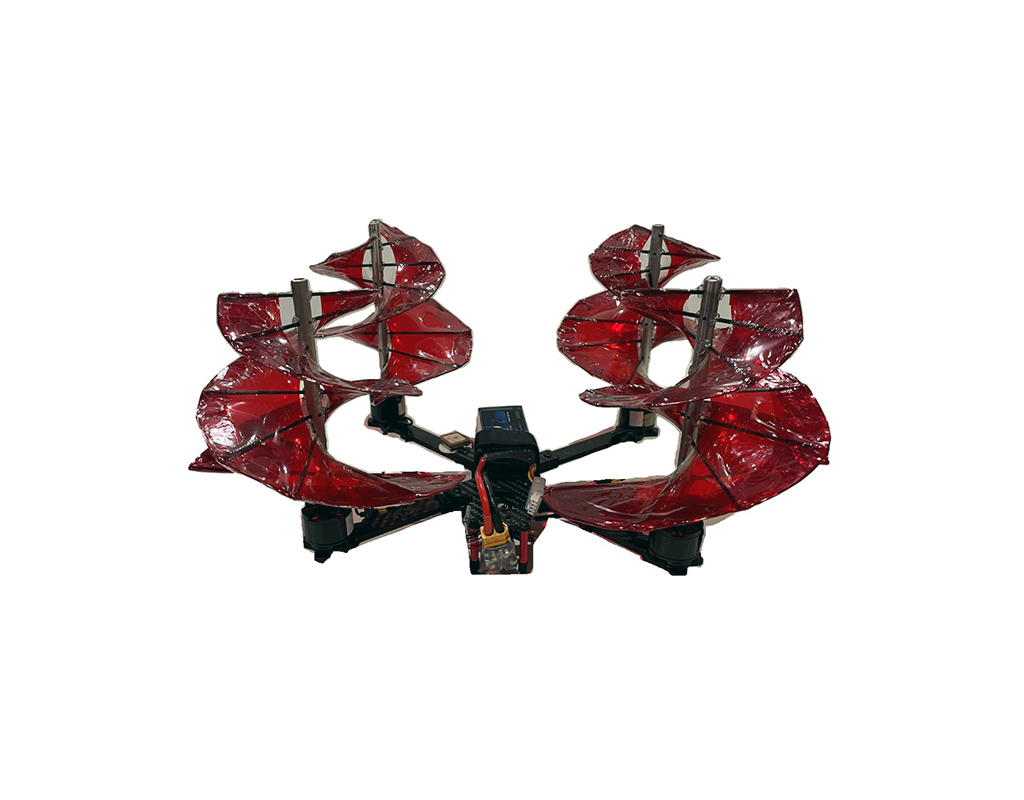
An engineer used Leonardo da Vinci’s aerial screw concept to create a flyable drone that may have lessons for the future of vertical lift.
In the final months of 2020, Austin Prete embarked on a project more than 500 years in the making.
As he worked on a master’s degree in aeronautical engineering at the University of Maryland (UMD), Prete began to test, and eventually fly, a small quadcopter drone propelled by aerial screws based on Leonardo da Vinci’s design for a helicopter in the late 1480s.
Da Vinci’s helicopter was designed with compact, helix-shaped rotors and likely never flew in his lifetime thanks to the limited technology and lack of lightweight materials available to him.
And while Prete’s aircraft — called Crimson Spin — isn’t likely to be adopted by helicopter or eVTOL developers any time soon, it does provide an enticing bit of brain candy for engineers trying to plot the future of vertical lift.
Will we ever see a vehicle with aerial screws carrying human passengers?
“It definitely seems possible,” said Prete, who is now an engineer at Aurora Flight Sciences, a Boeing subsidiary. “However, there needs to be a willing party interested enough to fund and develop that vehicle.”

Crimson Spin is based on UMD’s winning entry in the 2019/20 Vertical Flight Society Student Design Competition, sponsored that year by Leonardo Helicopters.
The competition challenged students to design a human-carrying aircraft with propellers that resembled da Vinci’s helicopter rotors — which in turn resembled an Archimedes screw.
During the pandemic, Prete — a member of UMD’s winning team in 2020 — decided to further research the design’s potential, albeit on a much smaller scale.
The UMD design called for rotors with a diameter of eight feet to produce enough lift to carry human passengers. Prete’s design used rotors with a diameter of just six inches.
He also added a second blade to each screw — in effect, creating a double-helix for each — which helped stabilize the original single-surface design during flight.
“The original aerial screw [had] one blade, one surface, so [it was] inherently unbalanced,” he said.
Although the UMD team used 3D printing to create its aerial screws, Prete said his were hand-fabricated with an aluminum shaft, composite spars, and hobby-grade mylar for the skin surface.
“At the start of the competition, most of the students in the team also disregarded it as impossible until testing, and the computational fluid dynamics actually proved it was possible,” Prete said. “Even still, going into my part of this project, I didn’t have concrete belief that it would actually fly.”
At this stage, the Crimson Spin can only fly for a few seconds at a time. While hovering is no problem, aerial screws don’t provide much forward thrust, so moving laterally is a challenge.
But in a controlled setting the aircraft still travels several feet above ground and can gradually move around a room. Prete noted aerial screws could be quieter than typical rotors and he sees potential real-world applications for drone-based video shoots.

“Say you want to have an aerial footage shot, but you don’t want rotor blades making loud noises or large amounts of downwash,” he said. “You could then swap that out for an aerial screw, which would have less downwash, less noise.”
Perhaps most interesting from an engineering perspective, Prete said he was able to show that aerial screws produce leading-edge vortices that closely resemble those created by delta wing aircraft like the space shuttle and the supersonic Concorde jet.
“They’re essentially the same thing, but using a different way of moving the air,” he said.
Crimson Spin’s aerial screws achieve most of their lift by creating vortices that flow over the tip of the screws and create a low-pressure zone on their upper surface.
By creating a higher-pressure zone on the underside of the screw, it propels the aircraft upward.
“The aerial screw, contrary to popular belief, does not produce [a large amount of] thrust by directing air downward,” he said. “It is almost entirely the aerial screw’s bound-tip vortex which generates the thrust.”
So, is this a new model for ultra-fast travel?
“I don’t necessarily think aerial screws would be good for that application,” Prete said. “Their forward flight speed is going to be at a detriment compared to other rotorcraft. But in cases of hover, aerial screws perform the same. I’m not entirely sure about the supersonic regions of it. But it is something to explore, considering the experience with the delta wing aircraft.”
If nothing else, Crimson Spin may serve as a launching pad for further study. It’s also further confirmation that da Vinci was a genius well ahead of his time.
“I would be lying if I didn’t say that didn’t come to mind,” Prete said. “Considering the lack of — at that point — any human powered or human carrying capable flight technology, that is quite impressive.”

